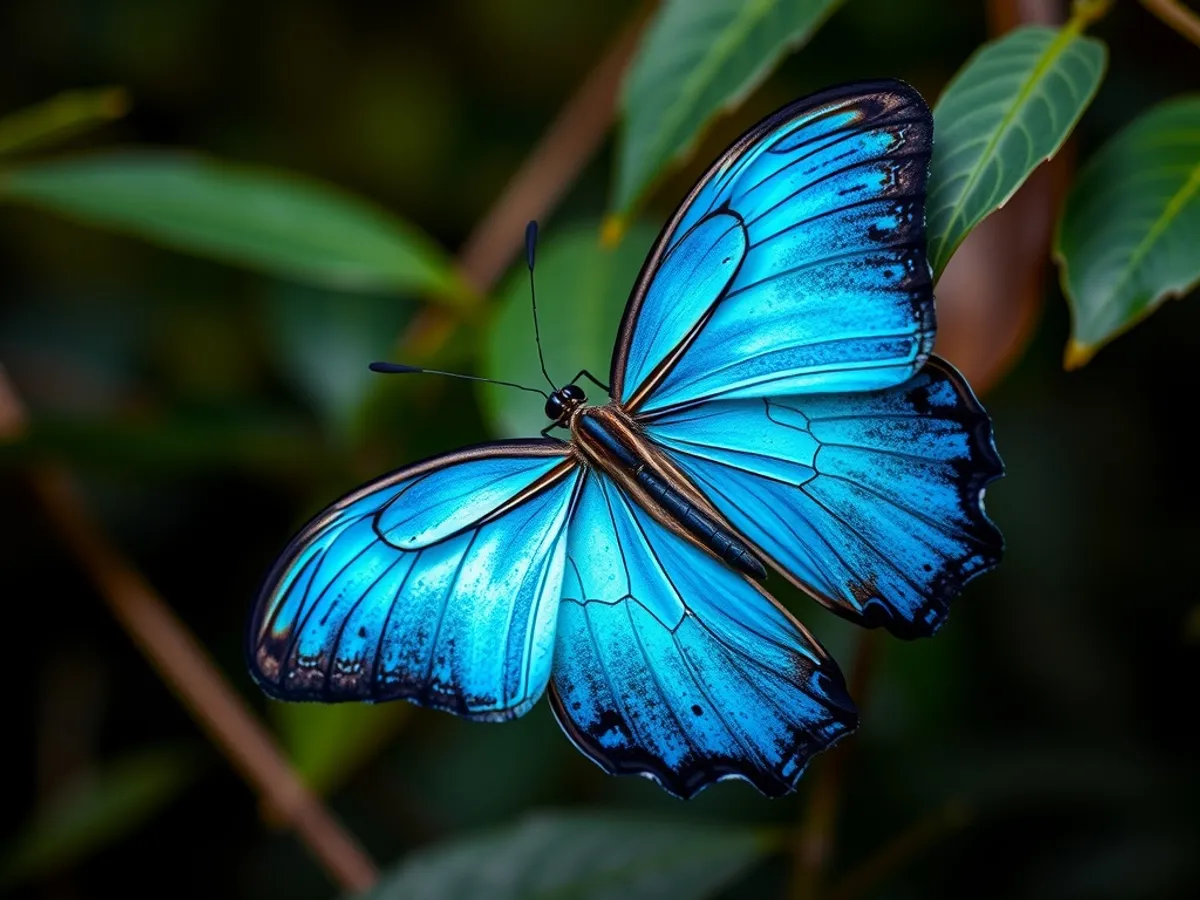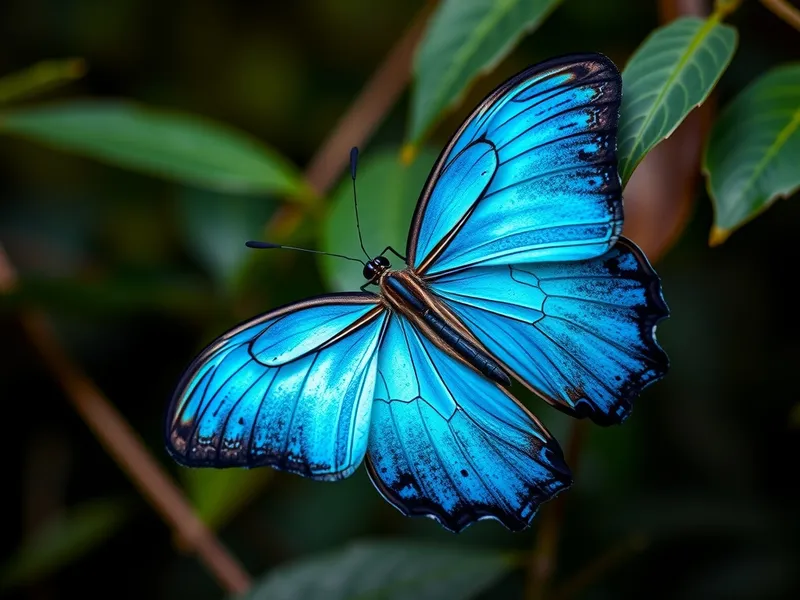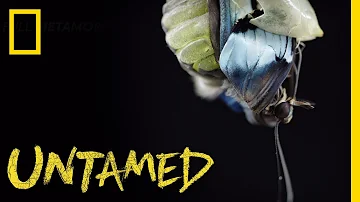
Blue Morpho Butterfly
Morpho menelaus

Meet the Blue Morpho Butterfly
The Blue Morpho Butterfly is one of the largest and most striking butterflies in the world, easily recognized by its vivid, iridescent blue wings. Native to the tropical forests of Central and South America, this butterfly uses its brilliant coloration to startle predators and communicate with other morphos. The Blue Morpho spends most of its time in the lower understory, feeding on fermenting fruit and occasionally tree sap. Its lifecycle includes a remarkable metamorphosis from caterpillar to adult, with each stage adapted to survive in the dense rainforest environment.
Classification
Invertebrate
Habitat
Tropical rainforest
Diet
Herbivore
Lifespan
115-130 days (from egg to adult)
Conservation
Least Concern
Weight
2-3 grams
📖Fascinating Facts
Iridescent Wings
The Blue Morpho's wings appear bright blue due to structural coloration, not pigment, reflecting and refracting light to create their dazzling hue.
Rainforest Dweller
Blue Morpho Butterflies are found primarily in the tropical rainforests of Central and South America, especially along riverbanks and in the lower forest canopy.
Fruit Lover
Unlike many butterflies that sip nectar, adults prefer the juices of fermenting fruits, which provide energy and nutrients for their short adult lives.
📋Detailed Description
The Blue Morpho Butterfly (Morpho menelaus) is renowned for its vivid, iridescent blue wings, which span 12–15 centimeters (4.7–5.9 inches), making it one of the largest butterflies in the Neotropics. The brilliant blue coloration is not due to pigment but to microscopic scales on the dorsal wing surfaces that reflect and refract light, a phenomenon known as structural coloration. The ventral side of the wings is brown with eye spots, providing camouflage when the butterfly is at rest. Adult Blue Morphos are primarily active during the day (diurnal) and are most often seen fluttering through the lower to mid-canopy of tropical rainforests from Mexico to northern South America, including Brazil, Peru, and Venezuela. Their flight is strong and erratic, which, combined with their flashing blue wings, confuses predators. The species is solitary outside of mating periods, with adults feeding mainly on fermenting fruit, tree sap, and occasionally fungi, using their proboscis to extract nutrients. Larvae (caterpillars) are reddish-brown with tufts of hair and feed on the leaves of leguminous plants, particularly those in the Fabaceae family. The Blue Morpho undergoes complete metamorphosis: egg, larva, pupa (chrysalis), and adult, with the chrysalis being pale green and resembling a leaf for camouflage. Adults typically live for about 115 days, during which time their main focus is reproduction.
💡 Did you know?
The Blue Morpho's wings appear brown when closed, making it nearly invisible against the forest floor, but flash an electric blue when open, startling would-be predators.
🔬Research & Sources
Wikipedia Summary
Blue morpho may refer to several species of distinctly blue butterfly under the genus Morpho, including:Morpho achilles Morpho cypris Morpho didius Morpho helenor Morpho menelaus Morpho peleides Morpho rhetenor
Last Modified: 12/30/2024
🎭Behavior & Social Structure
Blue Morpho Butterflies are primarily solitary and territorial, with males often patrolling specific flight paths along forest edges and streams to locate females and defend their territory from rivals. Their erratic, slow, and undulating flight pattern is a defensive adaptation to evade predators such as birds, reptiles, and small mammals. When threatened, they close their wings to display the cryptic brown underside, blending into the forest environment. Feeding occurs mainly on fermenting fruit, which provides both sugars and minerals; adults are also attracted to tree sap, rotting fungi, and even animal dung. Blue Morphos are crepuscular, being most active in the early morning and late afternoon, and tend to rest with wings closed during the hottest part of the day. Communication is primarily visual, with males using their iridescent wings to signal to females and deter competitors. They do not form aggregations, but multiple individuals may be seen in the same area if food resources are abundant.
👶Reproduction & Life Cycle
Reproduction in Morpho menelaus is seasonal, often coinciding with the onset of the rainy season when host plants are most abundant. Males patrol territories and use their blue wings to attract females, engaging in aerial courtship displays. After mating, females lay eggs singly or in small clusters on the underside of host plant leaves, primarily from the Fabaceae family. The eggs hatch in about 8–14 days, and the caterpillars go through five to six instars over a period of 3–4 weeks. The pupal stage lasts approximately 2–3 weeks, during which the chrysalis remains well-camouflaged. There is no parental care after egg-laying; all life stages are independent. In favorable conditions, multiple generations may occur annually.
🛡️Adaptations & Survival
The Blue Morpho exhibits several remarkable adaptations for survival. Its structural blue coloration serves both as a warning and a startle mechanism, making it difficult for predators to track during flight. The cryptic brown ventral wing surface with eye spots provides camouflage and may deter predation by mimicking the eyes of larger animals. Larvae possess urticating hairs and secrete toxic chemicals derived from their host plants, deterring predators such as ants and birds. The adults’ preference for fermenting fruit allows them to exploit a food resource less used by other butterflies. Their strong, erratic flight and ability to rapidly change direction further enhance their ability to evade capture.
📚Research Sources
🎨Cultural Significance
The Blue Morpho holds significant cultural value in Central and South America, symbolizing transformation, beauty, and the ephemeral nature of life. Its striking appearance has inspired indigenous myths, art, and jewelry. In modern times, it is a popular motif in eco-tourism, butterfly houses, and educational programs, often serving as an ambassador for rainforest conservation. The butterfly’s image is widely used in branding and as a symbol of biodiversity. In some cultures, sighting a Blue Morpho is considered a sign of good luck or a spiritual message.
🔬Recent Research & Discoveries
Recent research on Morpho menelaus has focused on the nanostructures responsible for its iridescent coloration, with applications in biomimetic materials and anti-counterfeiting technologies. Studies have also examined its role in forest ecosystems as a pollinator and decomposer, as well as its interactions with predators and parasitoids. Ongoing genetic research aims to clarify the evolutionary relationships within the Morpho genus and to understand the genetic basis of wing coloration. Conservation studies are monitoring the impact of habitat fragmentation and climate change on population genetics and migration patterns.
🎥Wildlife Videos

Blue Morpho Butterfly | Untamed
About Untamed with Filipe DeAndrade: Follow Filipe and his two best friends as they travel the United States in search of the most ...
Nat Geo Animals

Discovering the Blue Morpho Butterfly: Nature's Living Sapphire #nature #butterfly
Step into the enchanting world of the Amazon rainforest and discover one of nature's most breathtaking creations, the Blue ...
Wisdom Reality Quest

Blue Morpho Butterfly - 5 Minute Documentary
Embark on a dazzling journey through nature's wonderland with a mesmerizing five-minute documentary unveiling the ethereal ...
Five Minute Documentaries

The Secret And Fascinating Life Of A Butterfly | Real Wild
Elegant and graceful butterflies never cease to fascinate and impress, yet these amazing insects begin life as little worm-like ...
Real Wild

Sienna's Morpho Butterfly Documentary
A short documentary about the Amazonian Rainforest Morpho Butterfly, created by a Year 6 student using Photostory3.
MrsEsClass

Big, Beautiful, and Blue Morpho Butterfly
The Blue Morpho Butterfly is featured in this chapter of Adriana's Wildlife Adventure in Costa Rica. It's all about celebrating the ...
James Wolfe
🌍Habitat Information
The Blue Morpho Butterfly typically inhabits Tropical rainforest environments. Blue Morpho Butterflys have adapted to their environments with specialized features and behaviors.
Primary Habitat:
Tropical rainforest
More detailed habitat information will be available soon.
🛡️Conservation Status
The Blue Morpho Butterfly is currently classified as Least Concern. Conservation efforts are crucial for preserving this species for future generations.
Common Threats:
- 🏠Habitat loss and fragmentation
- 🌡️Climate change impacts
- 🎯Hunting and poaching
- 🏭Human-wildlife conflict
⚠️Threats & Conservation Challenges
While Morpho menelaus is currently listed as Least Concern, it faces several threats, primarily habitat loss due to deforestation and agricultural expansion in the Amazon and other tropical forests. Collection for the butterfly trade, both for scientific specimens and decorative purposes, can also impact local populations, especially in areas with high tourist activity. Pesticide use and climate change pose additional risks by altering the availability of host plants and suitable habitats. Despite these challenges, the species remains relatively widespread and adaptable, but ongoing habitat destruction could lead to localized declines.
🔬Scientific Classification
Scientific Name
Morpho menelaus
Classification Hierarchy
🔍 About Taxonomic Classification
Taxonomic classification is a hierarchical system used by scientists to classify and organize living organisms based on shared characteristics and evolutionary relationships.
The system moves from broad categories (Kingdom) to increasingly specific ones, with each animal's scientific name typically consisting of its Genus and species.
📝Community Notes
Share your observations and insights about the Blue Morpho Butterfly with our community of wildlife enthusiasts.
Join Our Community
Sign in to share your observations and connect with fellow wildlife enthusiasts.
Sign In to ContributeNo community notes yet
Be the first to share your observations about the Blue Morpho Butterfly!
Explore Blue Morpho Butterfly
Select a tab above to learn more about this amazing animal.
📸Photo Gallery
No photos available for this animal yet.
🌟Discover More Wildlife
Continue your journey of discovery with more fascinating animals from our database
